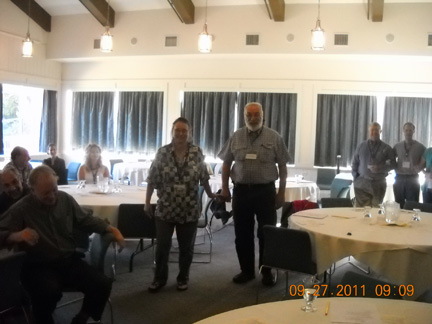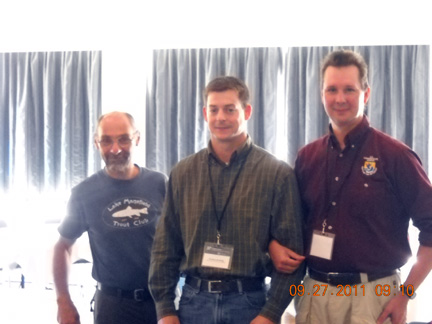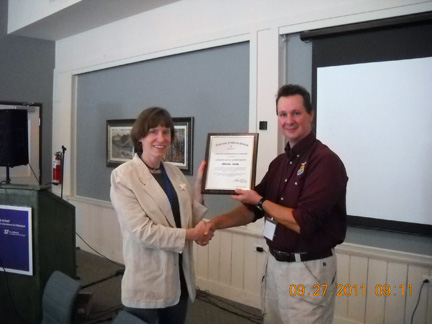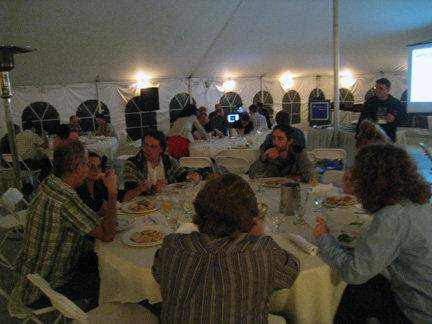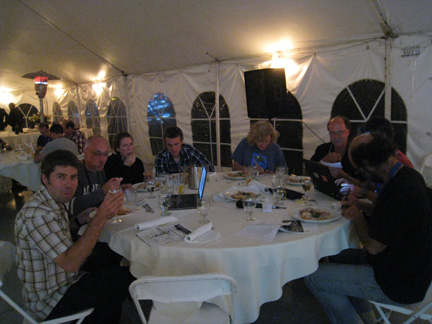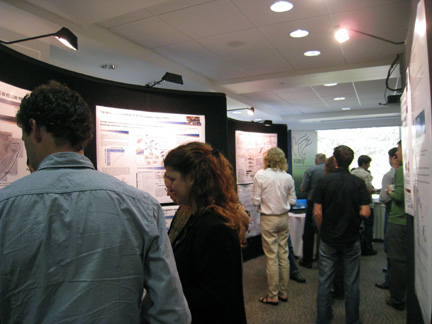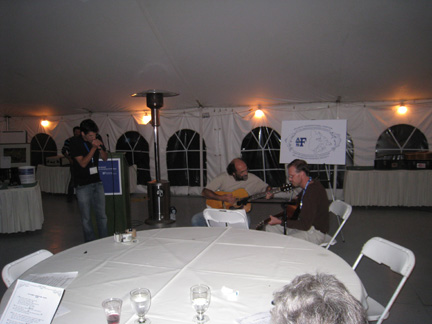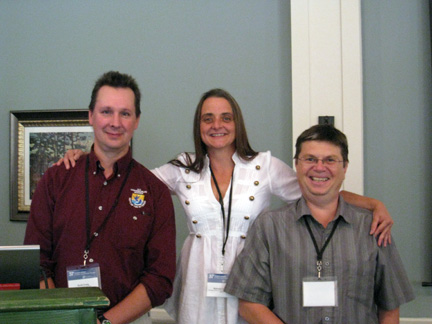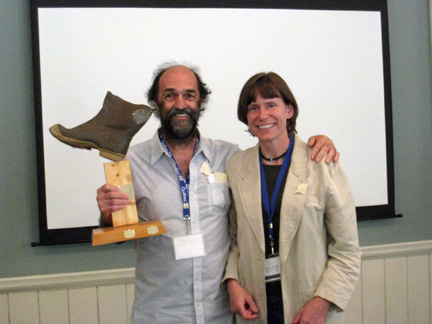37th Annual Meeting of the
Atlantic International Chapter of the American Fisheries Society
September 25-27, 2011
Le Manoir du Lac Delage
Québec, Canada
Download Summary of Conference:
• AIC-Conference-2011 (DOC)
• AIC-Conference-2011 (PDF)
2011 AIC Business Meeting Minutes
Hotel Information
Le Manoir du Lac Delage
40, Avenue du Lac, Lac Delage
Québec, G3C 5C4
Conference Schedule
| Sunday, September 25th | |
| 3:00 pm – 7:00 pm | Registration |
| 7:00 pm – 9:30 pm | Sunday Evening Session (and Mixer) Moderators: Yves Mailhot, Yves Paradis, and Pierre Dumont |
| Free beer from 7:00 to 8:00 | |
| Yves Mailhot, Yves Paradis, and Pierre Dumont – Tasty talks | |
| John Magee – The Nash Stream Restoration Project | |
| Jud Kratzer – Tropical Storm Irene and Vermont’s 2011 Flood | |
| Joan Trial – Update on Atlantic Salmon in Maine | |
| Trevor Avery – An inexpensive underwater video system for fish movements, eel trapping, and habitat mapping | |
| Louise Deschenes – 2014 AFS Meeting in Quebec City | |
| Open Mic- Informal Presentations of what you have been working on…. | |
| Monday, September 26th | |
| 7:00 am – 8:00 am | Breakfast |
| 8:10 am – 8:30 am | Welcome and Introductions |
| 8:30 am – 9:10 am | Key Note Speaker: Marc Mingelbier – Fish management in the Province of Quebec: a brief overview with an emphasis on the St. Lawrence River |
| Technology Moderator: Joan Trial- Maine Bureau of Sea-Run Fisheries & Habitat |
|
| 9:10 am – 9:30 am | Graham Goulette – Increasing acoustic tag detection efficiencies by altering vertical placement of hydroacoustic receivers |
| 9:30 am – 9:50 am | Richard Vallée – Telemetry techniques for fishery scientists |
| 9:50 am – 10:10 am | Scott Pavey – Non-parallelism in MHC IIB exon 2 diversity and pathogen infection phenotypes in lake whitefish (Coregonus clupeaformis) species pairs as revealed by next generation sequencing |
| 10:10 am – 10:30 am | Coffee Break |
| Fisheries Management Moderator: Graham Goulette- NOAA Fisheries |
|
| 10:30 am – 10:50 am | Scott Craig – Strategic and cooperative conservation efforts in action: USFWS Maine fishery resources office collaborations in downeast Maine |
| 10:50 am – 11:10 am | Julie Deschenes – Adapting a lake trout management tool |
| 11:10 am – 11:30 am | Lyne Morisette – Why has the cod gone? Investigating effects of various harvest regimes on fishery yield and ecosystem health indicators of two coastal ecosystems: a Canada-Norway contrast |
| 11:30 am – 11:50 pm | Joan Trial – Habitat and temperature models; more informative than recollections of lake conditions |
| 12:00 pm – 1:30 pm | Lunch |
| Ecology Moderator: Kathryn Collet- New Brunswick Dept. of Natural Resources-Fisheries |
|
| 1:30 pm – 1:50 pm | Phillipe Brodeur – Oligotrophication from wetland epuration alters riverine trophic network and carrying capacity for fish |
| 1:50 pm – 2:10 pm | Danielle Quinn – Characteristics of freshwater fish assemblages and fifty-year population trends of freshwater and anadromous fish species in Nova Scotia |
| 2:10 pm – 2:30 pm | Luke Poirier – Distribution and detection of American eels (Anguilla rostrata) in brackish and salt water on the east coast of Canada from historic data |
| 2:30 pm – 2:50 pm | Mélanie Dionne – Ecological and genetic characteristics in Atlantic salmon in Quebec: the implication for management and conservation |
| 2:50 pm – 3:30 pm | Coffee Break and Poster Session |
| Outing Marais du Nord |
|
| 3:30 pm – 5:30 pm | Transportation in bus |
| 6:00 pm – 8:00 pm | Dinner and Social |
| 9:00 pm – 10:30 pm | Bonfire |
| Tuesday, September 27th | |
| 7:00 am – 8:00 am | Breakfast |
| 8:00 am – 10:00 am | BUSINESS MEETING |
| 10:00 am – 10:20 am | Coffee Break |
| Species focus Moderator: Scott Craig – USFWS Maine Fishery Resources Office |
|
| 10:20 am – 10:40 am | Guy Verreault – Atlantic sturgeon fishery management in the St. Lawrence Estuary, QC |
| 10:40 am – 11:00 am | Nathalie Vachon – Twenty-five years of research, management and protection of an endangered freshwater fish: the copper redhorse |
| 11:00 am – 12:00 pm | RAFFLE, LUNKER AWARD, SOGGY BOOT AWARD, AND WRAP UP |
| 12:00 pm – 1:30 pm | Lunch |
Abstracts
Primary Author:
Joan Trial
Maine Department of Marine Resources (ME DMR)
[email protected]
Title: Update on Atlantic salmon in Maine
There are more adult Atlantic salmon in Maine rivers this year than there have been for a fairly long time, indicating good marine survival for smolts leaving northern North American rivers in 2009 and 2010. The 2011 Atlantic salmon returns to Maine rivers with fishway traps or weirs are just over two times the average of the previous five years (2006 to 2010). The largest run in the state (3 090 as of the morning of September 19) this year, as usual, is to the Penobscot River, which is stocked with smolts each spring. The last year the number of Atlantic salmon captured at the trap on the Penobscot exceeded 3 000 was 1986. The next highest return for the season, 185 salmon, is to the Narraguagus River where stocking Atlantic salmon smolts has been included in the mix of strategies to restore spawning adults since 2008. It has been twenty years (1991) since the Narraguagus River has had over 160 spawners return. Ninety four salmon have returned to the Saco River, to date. On the Kennebec River where there are only two stocking strategies, putting egg in gravel in winter and releasing adult, 62 salmon have been passed upriver. This number is over twice the highest return of 27 in 2009, with 2011 the fifth year DMR has had counts at a fishway trap. Returns to the Dennys (8) rivers are comparable to those in the last five years.
Primary Author:
John Magee
New Hampshire Fish and Game Department
[email protected]
Contributors:
Jim MacCartney, Trout Unlimited
Title: The Nash stream restoration project
Historically, Nash Stream was known as a high quality native Brook trout stream that provided exceptional angling opportunities. It is also former Atlantic salmon habitat. Unfortunately, fish passage and instream and riparian habitat are significantly degraded as a result of past logging and gravel mining activities, including log drives. To make matters worse, the dam used to release water from Nash Bog Pond for log drives failed catastrophically in 1969, sending a torrent of water akin to the 500-year flood event down Nash Stream. Immediately thereafter, some areas of Nash Stream were straightened and its banks made higher by bulldozers, to the detriment of brook trout and other native fish species. Poorly designed culverts along old logging roads compounded matters by blocking or impeding fish passage to critical tributary habitat. As a result, Nash Stream no longer supports a robust, wild brook trout fishery, and offers less than ideal habitat for the recovery of Atlantic salmon. Centuries will pass before Nash Stream can heal on its own. The Nash Stream Restoration Project is a multi-year, collaborative restoration effort that seeks to improve the watershed’s conditions so that it once again functions as a healthy and self-sustaining coldwater fishery. We are committed to restoring aquatic habitat and fish passage in the drainage to support a healthy and self-sustaining population of wild brook trout and other fish species. Ultimately, the Project will restore over nine miles of mainstem habitat and access to more than four miles of tributary habitat for brook trout and other native species, and help to facilitate future management of the watershed as a wild trout fishery. We will present our assessment of fish and habitat conditions, the restoration planning and design process, the monitoring of habitat and fish populations, and some things we learned along the way.
Primary Author:
Len Gerardi
Vermont Fish and Wildlife Department
Contributors:
Jud Kratzer, Vermont Fish and Wildlife Department, [email protected]
Shawn Good, Vermont Fish and Wildlife Department
Title: Tropical storm Irene and Vermont’s 2011 flood damages
Some of the worst flooding in Vermont’s recorded history occurred in August 2011, when tropical storm Irene dumped huge volumes of rain in central and southern Vermont. At least four lives were lost in the flooding, and damage to buildings, roads, and bridges was extensive. This presentation includes photos from during and after the flood with some brief discussion of the potential effects of the flood on fish and fish habitat. It seems that the worst damage to fish habitat did not occur during the flood, but it is occurring now as town and state crews work in an emergency response mode to repair infrastructure, armor stream banks, and channelize some river reaches.
Primary Author:
Trevor Avery
Acadia University
[email protected]
Contributors:
Conor Cox, Acadia University
Jon Cottreau, Acadia University
Title: An inexpensive underwater video system for fish movements, eel trapping, and habitat mapping
Underwater video monitoring is used in many marine and freshwater systems to monitor biological interactions or survey habitats. Large-scale, anchored systems such as LEO, NEPTUNE, and BBO, and transportable systems such as ROVs provide insights not available through traditional sampling, but do so at high cost. We used a low-cost, transportable video monitoring system to capture underwater activities of Striped Bass in a tidal river, American Eels during trapping, and mapped habitat areas within a small lake. The technical aspects of video capture for quantification of habitat areas and observing behavior are assessed. Preliminary findings indicate that 1) grounding the field of view for context and perspective is critical to help quantify measurements such as fish swimming speed; 2) assessing study areas before experimental design may be helpful to reduce study costs; 3) image capture rate and compression can mitigate some effects of boat speed on still image quality; and 4) battery life is critical.
Primary Author:
Marc Mingelbier
Ministère des Ressources naturelles et de la Faune Québec (MRNF)
[email protected]
Title: Fish management in the province of Quebec: a brief overview with an emphasis on the St. Lawrence River
Since the early colony, fishing is an important element of Quebecers’ lifestyle. The Quebec Province, which spans over 1.7 million km2 includes 4 500 rivers and > 500 000 lakes and large reservoirs. Rivers and watersheds connect with the Great Lakes, Maritimes, Atlantic Ocean, Hudson Bay and Nunavut. This large territory is exposed to wide natural climatic variations. Most of, the ~7.5 million citizens live in the St. Lawrence river watershed. The ministère des Ressources naturelles et de la Faune (MRNF) is officially responsible for freshwater and migratory fish since 1922, while marine fish remain under Federal jurisdiction. In addition to the official fishing and hunting areas, Quebec also exhibits unique particularities in its structured territories (i.e. areas of controlled exploitation, outfitters, faunal reserves and national parks), with specific fishing rules and regulation, allowing comparisons between contrasting management scheme. The MRNF shares fish protection and restoration with >20 partners, has developed joint ventures with the Federal Government (species at risk, St. Lawrence Plan), international initiatives (Great Lakes Commission, International Joint Commission, Special Committees on eel and salmon) and collaborate with universities on numerous research projects involving fish management (Research Chair on sport fishing in Quebec). The MRNF is conducting large scale monitoring in inland waters and more specifically in the St. Lawrence River, which is threatened by increasing pressures. Those fundamental data, combined with habitat surveys and modeling, are used to support management decisions and for developing predictive models of fish populations, such as lake sturgeon, yellow perch, northern pike or walleye. Even if the fisheries are declining worldwide since the mid 1980’s, we have experienced several success stories with the lake and the Atlantic sturgeons and the reintroduction of the stripped bass. Today, we are mainly focusing on (1) maintaining or recovering the connectivity needed by migratory species in the St. Lawrence River, (2) considering fish requirement when regulating water flow, (3) modeling fish habitats, (4) using up-to-date technologies to delineate fish stocks (i.e. geochemistry, genetics), and (5) synthesizing all known information in an Atlas of vital habitats used by fish to achieve our goal of a management aimed toward prediction rather than a posteriori interventions.
Primary Author:
Graham Goulette
National Marine Fisheries Service (NMFS), National Oceanic and Atmospheric Administration (NOAA)
[email protected]
Contributors:
James Hawkes, National Marine Fisheries Service (NMFS), National Oceanic and Atmospheric Administration (NOAA)
Title: Increasing acoustic tag detection efficiencies by altering vertical placement of hydroacoustic receivers
Marine survival of many stocks of Atlantic salmon (Salmo salar) is at historic lows. Acoustic telemetry is being used to study salmon migration ecology and identify problem zones in Maine and southeastern Canada. Improved detection efficiency will increase spatial and temporal resolution of these efforts. While emigrating smolts are considered pelagic, using the top few meters of the water column, literature suggests they briefly sound to 10 m or deeper. Given general surface orientation, we typically deploy receivers at 10 m depth when total depth exceeds 25 m. In an attempt to improve our monitoring efforts, we tested the location of receiver deployments in Penobscot Estuary and Bay to determine the optimal vertical placement for increased detection efficiency at three sites. We found significant improvements in total detections with experimental depths used during this study (Kruskal-Wallace p < 0.05). At two sites, with depths up to 25 m, detection efficiency of smolts improved as much as 17% at experimental depths. At the third site, where the water column was greater than 25 meters, detection efficiencies improved by 9.2% at units placed 20 m deep versus 10 m deep. We also discovered while total detections were different according to placement, there were no significant differences between duration times nor did tide stage have a measurable effect on the detection of smolts. Our results can be used to improve detection probability in coldwater estuary zones between 10 and 100 m deep.
Primary Author:
Richard Vallée
Vemco
[email protected]
Contributors:
Dale Webber, Vemco
Denise King, Vemco
Title: New technology developments for understanding spatial and temporal activity patterns of fish in nature
Measurements of fish movements, activity, and energetics in nature, have always been technologically challenging. In many species around the world detailed movement and activity information is urgently required for a variety of reasons. Issues related to fishing pressure, habitat degradation, pollutants, and responses to environmental change are just a few of the many applications that require knowledge of the temporal and spatial movement and activity patterns of fish. Here we describe the development and implementation of a new multi-array positioning system (VPS – VR2W Positioning System) and a new activity acoustic transmitter (V9AP) that can be used in a variety of biological applications to study the behavior of fish in nature. VPS is more suited to a larger variety of applications compared to existing positioning systems that are constrained by cost and equipment deployment limitations (i.e., wire connecting hydrophones). A VPS study can be as small as 1 triangle covering 2500 m2 or less (3 receivers) and up to tens of kilometers2 and greater. To date VPS has been successfully used in small and large area studies in lakes, rivers and ocean environments. In this presentation we will discuss the design and specifications of VPS, the factors that influence positioning accuracy and we will show examples of various VPS study designs. We will also illustrate how to use an accelerometer transmitter to get the most of your VPS study.
Primary Author:
Scott A. Pavey
Universite Laval
[email protected]
Contributors:
Maelle Sevellec, Universite Laval
Eric Normandeau, Universite Laval
Pierre-Alexandre Gagnaire, Universite Laval
Fabien C. Lamaze, Universite Laval
Louis Bernatchez, Universite Laval
Title: Non-parallelism in MHC IIß exon 2 diversity and pathogen infection phenotypes in lake whitefish (Coregonus clupeaformis) species pairs as revealed by next generation sequencing
Major histocompatabiliy complex class IIß; (MHC) is a gene family vital to the adaptive immune system and also plays an important role in local adaptation and sexual selection. The exon 2 of this gene contains the peptide binding region responsible for presenting antigens from bacterial infections to T-cells. Whitefish have multiple copies of this gene so individuals may have more than two “alleles”. Here we use next generation sequencing to determine the MHC genotypes as well as presence of bacteria in the kidney of dwarf and normal lake whitefish (Coregonus clupeaformis); in five replicate lakes in Quebec, Canada and Maine, USA. We used 150 and 45 sequence tags for the genomic MHC genotyping and microbial bactotyping respectively to sequence many individuals in parallel with a 454 pyrosequencer. Out of 251 individuals, we found 52.3% individuals had bacteria present in the kidney. For the genotyping we found each individual had between one and five “alleles”, and there were a total of 29 alleles that differed in amino acid sequence. The patterns in bacterial infection and MHC diversity were not parallel among lakes and forms. We further explore how MHC diversity may affect infection diversity, and discuss implications for ecological divergence.
Primary Author:
Scott Craig
Maine Fishery Resource Office
[email protected]
Contributors:
Steven Koenig, Maine Fishery Resource Office
Title: Strategic and cooperative conservation efforts in action: USFWS Maine Fishery Resources Office in collaboration in downeast Maine
The Maine Fishery Resources Office (MEFRO) has been extremely successful in implementing subbasin scale (HUC 12) stream restoration efforts that embrace cooperative conservation with a myriad of State, Federal, Non-Governmental entities and private landowners. The presentation will discuss how MEFRO and Project SHARE (Salmon Habitat and River Enhancement) developed a strategic plan that has resulted in the completion of over 100 aquatic connectivity projects at stream-road crossings within designated critical habitat of endangered Atlantic salmon in downeast Maine. The Strategic Plan focused efforts within two Machias River subwatersheds that have high conservation merit in terms of both existing high quality salmonid habitat and projected long-term protection from threats such as urbanization and increased road development. Identification of priority focus areas allows financial resources to be directed in a cost-effective manner that increases the potential for long-term success of restoration activities. The Strategic Plan was instrumental in providing a foundation to organize and concentrate field collection efforts that catalogued “aquatic connectivity” issues within high priority focus areas. The resulting data and analysis included accurate cost estimates that allowed collaborators to successfully submit three award winning American Recovery and Reinvestment Act Projects (ARRA).
Primary Author:
Julie Deschênes
Ministère des Ressources naturelles et de la Faune Québec (MRNF)
[email protected]
Contributors:
Henri Fournier, Ministère des Ressources naturelles et de la Faune Québec (MRNF)
email
Title: Adapting a lake trout management tool
To evaluate lake trout habitat quality, we simplified and adapted a tool (mean volume-weighted hypolimnetic dissolved oxygen concentration) for use in Quebec lake trout fisheries management. Because upper layers in a lake are more voluminous, they weigh more in the calculation of the mean oxygen concentration than bottom layers. This is very labour intensive, requiring oxygen and temperature sampling and volume calculations at every meter. For widespread application, a simplification was needed. Quebec fisheries managers use standardized sampling procedures to profile dissolved oxygen and temperature in water columns, procedures which are already weighted. Sampling is done in three stages: at every meter until a certain depth, every two meters from then on to second depth and then every four meters to the bottom. A simple linear regression was used evaluated effectiveness of the simplified tool (mean of sampled dissolved oxygen concentrations in the hypolimnion) in mimicking the original one (mean volume-weighted hypolimnetic dissolved oxygen). Further comparisons were made with truncated profiles in order to examine the robustness of this adapted tool. Results revealed a close (R² = 0.984) and near equivalent (slope = 1,002) relationship between both tools. The adapted tool also proved robust to profile truncation. Corrections were developed for largely truncated profiles as well as differences in sampling dates.
Primary Author:
Lyne Morissette
Institut des sciences de la mer de Rimouski (UQAR-ISMER)
[email protected]
Contributors:
Torstein Pedersen, University of Tromsø, Norway
Silje Ramsvatn, University of Tromsø, Norway
Marianne Nilsen, International Research Institute of Stavanger (IRIS), Norway
Title: Why has the cod gone? Investigating effects of various harvest regimes on fishery yield and ecosystem health indicators of two coastal ecosystems: a Canada-Norway contrast
Coastal ecosystems have been affected by fishery and other harvesting strategies for a long time, but the knowledge of how these activities affect fishery yield and ecosystem structure and –health are still limited. Traditional harvesting in northern coastal ecosystems has targeted top predators, but in more recent years, small pelagic fish such as herring and capelin, as well as crustaceans (shrimp) have been exploited. In this paper, ecosystem models (ECOPATH with ECOSIM) of two ecosystems that are, or were, cod-dominated, the Norwegian Sørfjord and the Gulf of St. Lawrence, are used to investigate effects of different harvesting strategies on fishery yield, and ecosystem structure and health. The models are based on extensive empirical data on catches, biomasses, mortality rates and feeding of various trophic groups, ranging from primary producers to top‐predators. In the the mid-1990s, large gadoids (cod, saithe and haddock) dominated the catches in Norway, while it was severely collapsed in eastern Canada. To investigate potential ecosystem effects on ecological groups and to identify system indicators of different harvest strategies, ecosystem states were simulated using ECOSIM. Fishing effort on the different target groups was varied to represent harvesting strategies, and a suite of ecosystem indicators were estimated based on the model output. Our comparative results suggest indeed that above a certain level of exploitation, ecosystems are unable to get back to the equilibrium they had in the past. Cod in the lightly exploited Sørfjord did not suffer from any collapse, and moreover the structure of this system seems to be more complex and mature. Not only does overexploitation change the structure of the ecosystem, but it seems that these structural changes can affect its resilience and hence the ability of the entire ecosystem to maintain its integrity and to provide services.
Primary Author:
Joan Trial
Maine Department of Marine Resources (ME DNR)
[email protected]
Contributors:
Rob Dudley, United States Geological Survey (USGS)
Title: Habitat and temperature models; more informative than recollections of lake conditions
In 2009, the U.S. Geological Survey began an analysis of historical habitat and surface temperatures for Spednic Lake funded by the International Joint Commission, St. Croix River Board. The goals were to quantify the effects of lake level management and meteorological conditions on smallmouth bass year-classes. In 2009, USGS acquired acoustic data on lake bathymetry and bottom sediment. Annual estimates (1970 to 1990) of smallmouth-bass-spawning-habitat area were calculated in GIS using lake-levels during smallmouth bass spawning (May-June) and a model that used depth and substrate. Spawning habitat availability varied considerably over the period, with over 1,000 ha available in 21 of the years. Minimum lake level during spawning explained most of the variability in available nearshore areas with slopes less than 10 degrees. Change in lake level during spawning explained most of the variability in available habitat for areas where slopes ranged from 10 to 40 degrees. In 1978, 1981, 1985, 2001, 2004, 2006 we predicted less than 650 ha of habitat were available to spawning bass. We developed regressions to estimate daily lake surface temperatures from daily air temperature for Big Lake, which were accurate and portable to another lake in the St. Croix Watershed. Estimated daily surface water temperatures for Spednic Lake from 1970 to 2008 were used to predict smallmouth bass spawning periods, egg and fry mortality, summer growth, and overwinter mortality for each year. Mortality of eggs and fry during incubation was predicted in most years and was over 30% in ten years. In eight of the years, juvenile bass produced late in the spawning period had expected winter mortality greater than 25% based on their predicted size. Considering these predicted cohort characteristics, we identified 1986, 1996, and 2000 as years that temperature was likely to have had the greatest effect on year class strength in Spednic Lake between 1970 and 2008.
Primary Author:
Philippe Brodeur
Ministère des Ressources naturelles et de la Faune Québec (MRNF)
[email protected]
Contributors:
Christiane Hudon, Fluvial Ecosystem Research Section, Environment Canada
Antonella Cattaneo, Université de Montréal
Anne-Marie Tourville Poirier, Université de Montréal
Pierre Dumont, Ministère des Ressources naturelles et de la Faune Québec (MRNF)
Yves Mailhot, Ministère des Ressources naturelles et de la Faune Québec (MRNF)
Jean-Pierre Amyot, Fluvial Ecosystem Research Section, Environment Canada
Simon-Pierre Despatie, Fluvial Ecosystem Research Section, Environment Canada
Yves de Lafontaine, Fluvial Ecosystem Research Section, Environment Canada
Title: Oligotrophication from wetland epuration alters the riverine trophic network and carrying capacity for fish
Submerged aquatic vegetation constitutes a major component of fish habitat, providing support for epiphytes and invertebrates as well as shelter from predators. The effects of wetland epuration from a mesotrophic to a nearly oligotrophic state were examined over a 15-km-long reach of the St. Lawrence River under the direct influence of major farmland tributaries. We hypothesized that the nutrient-enriched zone would support a higher biomass of submerged aquatic vegetation, epiphytes, macro-invertebrates and fish than the nitrogen-deficient epurated zone located downstream of the wetland. Predictions included that the enriched habitat would support a richer fish assemblage, with higher biomass and growth of juvenile yellow perch (Perca flavescens) than found in the epurated zone. Results supported these hypotheses, demonstrating the chain of effects of nutrients reduction on the biomass of submerged aquatic vegetation (4-fold drop), invertebrate prey (9-fold), small (3-fold) and large (1.5 fold) fish between the two zones. In addition to the reduction of submerged aquatic vegetation biomass, the replacement of filamentous chlorophytes by benthic mats of filamentous cyanobacteria in the epurated zone resulted in a less complex 3-D habitat structure and a low invertebrate availability for fish. Oligotrophication by wetland epuration exerted negative effects on fish habitat quality, food quantity and availability, with an impairment of juvenile yellow perch growth and recruitment.
Primary Author:
Danielle Quinn
Acadia University
[email protected]
Title: Characteristics of freshwater fish assemblages and fifty-year population trends of freshwater and anadromous fish species in Nova Scotia
Significant variations in fish assemblage structure can be seen on local and regional scales. These variations are the result of multiple factors, both physical and biological, and may reflect overall watershed health. Changes in the population of particular species have the potential to influence local fish assemblage characteristics, and examining both population trends and fish assemblage structure across a wide spatial range may reveal large-scale, long-term patterns. Digitized data from electrofishing surveys conducted by the Department of Fisheries and Oceans Canada (DFO) since the mid 1960’s consist of three main types of information: (a) temporal: the data range from 1966 to 2009, and were collected during various seasons; (b) spatial: data were collected from 70 rivers in Nova Scotia, each with multiple sites; and (c) biological: counts of up to 30 species, some including life stage meta-data. The preliminary objectives of the study were to use the data to characterize fish assemblages using standard community indices, and analyze long-term trends and / or changes in these indices and fish populations across Nova Scotian rivers using a modeling approach. Future work includes the examination of non-native piscivore (specifically smallmouth bass) contribution to fish assemblage structure, and assessment of fish assemblage structure and non-native piscivore distribution in Nova Scotia.
Primary Author:
Luke Poirier
Acadia University
[email protected]
Contributors:
David Cairns, Department of Fisheries and Oceans Canada (DFO)
Trevor Avery, Acadia University
Title: Distribution and detection of American eels (Anguilla rostrata) in brackish and salt water on the east coast of Canada from historic data
Data from various monitoring surveys were assembled from a variety of locations around the east coast of Canada. A preliminary analysis included producing GIS maps and depth histograms that display fishing sets where eels were caught compared with those that were unsuccessful for eels. Where available, biological data were compared with temporal data in an attempt to gain insight into movement patterns of captured eels. In sets where eel numbers were more prominent, date and time of capture were compared to assumed migrations of silver eels and historical length-weight curves to address the possibility that habitat use was temporary. To aid similar analyses of monitoring data, a species list from these surveys was compiled. Further surveys will include the St Lawrence estuary, Scotian shelf, and the eastern coast of the United States.
Primary Author:
Mélanie Dionne
Ministère des Ressources naturelles et de la Faune Québec (MRNF)
[email protected]
Title: Ecological and genetic characteristics of Atlantic salmon in Quebec: the implication for management and conservation
Atlantic salmon is a migratory species that colonised multiple habitat types in North America. Scientific evidence suggests that local adaptation is an important evolutionary process for this species which resulted in various phenotypic and genetic characteristics. The aim of this presentation is to draw an overview of ecological and genetic characteristics of Atlantic salmon in Quebec as well as to discuss its potential for local adaptation. Results of multiple recent studies on the evolution and the genetic conservation of this species will be presented, covering its large scale genetic population structure, its potential for temperature and immune adaptation, its mate choice particularities and the implication on management and conservation.
Primary Author:
Guy Verreault
Ministère des Ressources naturelles et de la Faune Québec (MRNF)
[email protected]
Contributors:
Guy Trentia, Ministère des Ressources naturelles et de la Faune Québec (MRNF)
Title: Atlantic sturgeon fishery management in the St. Lawrence Estuary, Quebec
Atlantic sturgeon, Acipenser oxyrinchus oxyrinchus, has been commercially harvested in the St. Lawrence estuary for decades. After a severe crash between 1966 and 1976, this non-regulated fishery recovered, and landings peaked at record level in early 1990s with signs of overexploitation. Annual monitoring was set up in the mid-1990s in conjunction with fishing restrictions. Since then, size distributions in annual landings has moved in accordance with sturgeon sizes selected by fishermen. Fishermen preferably select sturgeons larger than 105 cm, but this behavior is counterbalanced by decreasing gillnet selectivity over this threshold. Regulation enforcement and fishermen’s compliance has helped to stabilize the landings, and our analyses suggest that Atlantic sturgeon population abundance is increasing and can sustain the fishery. The results from annual monitoring show that management measures are efficient, and that large sturgeons can escape the fishery and contribute to the spawning stock.
Primary Author:
Nathalie Vachon
Ministère des Ressources naturelles et de la Faune Québec (MRNF)
[email protected]
Contributors:
Pierre Dumont, Ministère des Ressources naturelles et de la Faune Québec (MRNF)
Jean Leclerc, Ministère des Ressources naturelles et de la Faune Québec (MRNF)
Sylvain Desloges, Ministère des Ressources naturelles et de la Faune Québec (MRNF)
Huguette Massé, Ministère des Ressources naturelles et de la Faune Québec (MRNF)
Paul Grondin, Ministère des Ressources naturelles et de la Faune Québec (MRNF)
Louis Bernatchez, Université Laval
Daniel Hatin, Ministère des Ressources naturelles et de la Faune Québec (MRNF)
The Copper redhorse recovery team
Title: Twenty-five years of research, management and protection of an endangered freshwater fish: the copper redhorse
Copper redhorse (Moxostoma hubbsi) is an endangered freshwater fish found exclusively in a very restricted area in southwestern Québec. The species was first described in 1866 by Pierre-Étienne Fortin but its official discovery is attributed to Vianney Legendre in 1942. Its rarity and its extremely precarious situation were quickly identified by biologists. Protection and recovery activities are the result of concerted efforts involving surveys, research, expertise and methods development, which guided the policies and their prioritization in the recovery plans. This presentation discusses the overall approach, the main steps and activities of research, management and protection targeted on the copper redhorse recovery that were conducted over the past 25 years. The legal aspects, habitat protection, stewardship, as well as monitoring of the population and the level of knowledge of the species life history will be presented. Our experiences highlight the importance of a team work involving many partners from different backgrounds and interest.
Primary Author:
Nathalie Boudreau
Ministère des Ressources naturelles et de la Faune Québec (MRNF)
EMAIL
Contributors:
Denise Deschamps, Ministère des Ressources naturelles et de la Faune Québec (MRNF)
Chantale Girard, Ministère des Ressources naturelles et de la Faune Québec (MRNF), Université du Québec à Chicoutimi (UQAC)
Véronique Leclerc, Ministère des Ressources naturelles et de la Faune Québec (MRNF)
Anne-Lise Fortin, Université du Québec à Chicoutimi (UQAC)
Pascal Sirois, Université du Québec à Chicoutimi (UQAC)
Marc Mingelbier, Ministère des Ressources naturelles et de la Faune Québec (MRNF), [email protected]
Title: Otolith aging and daily growth rate in yellow perch larvae
Precise measurements of age and growth are essential for fish stock management, enabling estimates of recruitment, mortality, migration and stock structure. Otolith reading at a daily scale also allows retrocalculation of hatching date, while specific marks identify major steps of the life cycle and feeding changes. We illustrated here a method developed and adapted to extract, mount, read and interpret otoliths in yellow perch larvae (<40 days). This method, which was used to study yellow perch recruitment in the lake Saint-Pierre area, was adapted for yellow perch juveniles (>40 days) and could be transferred to other fish species.
Primary Author:
Jean-Nicolas Bujold
Ministère des Ressources naturelles et de la Faune Québec (MRNF)
[email protected]
Contributors:
Michel Lemieux, Ministère des Ressources naturelles et de la Faune Québec (MRNF)
Martin Arvisais, Ministère des Ressources naturelles et de la Faune Québec (MRNF)
Ariane Massé, Ministère des Ressources naturelles et de la Faune Québec (MRNF)
Title: Using rotenone to restore brook trout populations in Quebec: Are the results conclusive?
In the province of Quebec, brook trout (Salvelinus fontinalis) is a very important native species. Anglers spend approximately 4 millions days per year fishing this species which generate about 600 millions dollars annually in direct and indirect benefits. Several lakes that contained only brook trout in the past have been invaded by introduced fish species that caused drastic declines in populations because of competition and predation. In order to control introduced species and restore brook trout populations in Quebec, fisheries managers have used rotenone in over 300 projects since 1943. We are currently doing a biological, social and economical analysis of these restoration projects to evaluate the success of the method and to improve its use. Our results show that 80 % of the rotenone treatments performed since 1972 have eradicated successfully introduced species in the covered lakes. In the last decade, this number has increased to 93 % due to the improvement and the standardization of the method. Strahler stream order and the number of lakes upstream influenced negatively eradication efficiency of introduced species. On another hand, fishing success, fish quality index, mean mass, fish yield and fishing pressure have increased significantly after the treatments. These variables have been found to be influenced by four lake characteristics: (1) Strahler stream order, (2) area of preferential habitat, (3) development of volume and (4) relative depth.
Primary Author:
Aline Foubert
UFR Biogéosciences – UFR Géographie et science des territoires, Université Paris Sept, France
Contributors:
Marc Mingelbier, Ministère des Ressources naturelles et de la Faune Québec (MRNF), [email protected]
Mathieu Cusson, Université du Québec à Chicoutimi (UQAC)
Frédéric Lecomte, Ministère des Ressources naturelles et de la Faune Québec (MRNF), Université du Québec à Chicoutimi (UQAC)
Title: Loss of heterogeneity in the fish community of a Biosphere reserve: how long-term surveys warn us of major things to come
Signs of ecosystem modifications may be noticeable before they become major and irreversible. To detect such modifications in the St. Lawrence River, we rely on fish community surveys conducted since the 1970’s. Historical fish samplings were collated in a common database (Atlas of the vital habitats of the St. Lawrence fishes), enabling temporal comparisons. We select the Lake St.-Pierre archipelago (LSPA) to test for changes in fish diversity between four sampling periods (1971-1973, 1995, 2003, 2010). The LSPA is one of the most diversified areas within the St. Lawrence River and was included in 2000 in the UNESCO Biosphere Reserves. Traditional diversity indices were calculated for each sampling station and period (i.e. Pielou’s J; Simpson’s DS; Shannon-Weaver H’). Indices corrected for the unequal sampling effort revealed a profound change in the community. For example, in 1971 it was possible to capture over 45 distinct species in the LSPA (Hurlbert’s rarefaction index ES(n)), whereas this value changed to 41 in 2010 (including the new invasive round goby). While this reduction in diversity may not appear that important at the scale of the LSPA, heterogeneity in the community at a smaller spatial scale has been completely modified. For example, in 1971, on average, one sweep of a 21.8 m seine captured 8.7 different species while in 2005-2010, a smaller seine of 12.5 m sampled on average 13.9 distinct species per sweep. Thus, species distribution becoming more homogenous while being less diversified globally; in 1971 many sites needed to be sampled to collect all species while in recent year, a few sweeps were enough to capture all species present. Identifying the cause or mechanism underneath such unexpected alteration of the community should be seen as a prime goal to implement actions before more species became locally extirpated.
Primary Author:
Frédéric Lecomte
Ministère des Ressources naturelles et de la Faune Québec (MRNF), Université du Québec à Chicoutimi (UQAC)
Contributors:
Marc Mingelbier, Ministère des Ressources naturelles et de la Faune Québec (MRNF), [email protected]
Aline Foubert, UFR Biogéosciences – UFR Géographie et science des territoires, Université Paris Sept, France
Title: The atlas of vital habitats of the fishes of the St. Lawrence River: a major repository of information and an indispensable tool for synthesizing knowledge about fishes, habitats and perturbations
We present the key features and intended utility of the Atlas of the vital habitats of the St. Lawrence fishes. This new project is intended to fully exploit the large datasets accumulated over the years to better understand fish population dynamics (recruitment, spatial distribution, connectivity, source-sink dynamics, etc.). As we develop a management approach oriented towards prediction / anticipation to minimize negative effects rather than a posteriori interventions to correct overexploitation, it becomes mandatory to understand the influence of the environment on population dynamics both locally and globally. We aim to retrieve the information collected on fishes (number, life-history stages, species, etc.), on habitats (depth, velocity, etc.) and on perturbations (dredging, dams, drainage basins alterations, etc.). More than 1.7 million entries (mainly fish observations) spanning from 1928 to 2011 are already geo-referenced and integrated in the Atlas with similar datums. Although this initiative is only at its beginning, it has already provided an opportunity to test for modification in diversity of the fish community (see Foubert et al. poster). The actual compilation reveals important gaps in the spatial distribution of past studies / surveys. Several areas were underrepresented creating the impression that some regions are ecologically (or demographically) disjunctive. Another key element missing for many species is the lack of information on early-life history stages.
Primary Author:
Antoine Richard
Université Laval
[email protected]
Contributors:
Louis Bernatchez, Université Laval
Mélanie Dionne, Ministère des Ressources naturelles et de la Faune Québec (MRNF)
Title: Impact of catch and release on Atlantic salmon (Salmo salar) migration and reproductive success
Atlantic salmon stocks have been declining rapidly worldwide since the middle of the 20th century and are now at historic lows. Mandatory catch and release have since been introduced to minimize the impact of recreational fishing on wild populations. Today, more than half of the salmon caught by sport fishing in Québec rivers are released. The aim of this study is to measure the impact of catch and release and angling procedures on two fitness components in Atlantic salmon: upstream migration and reproductive success. The study took place on the Escoumins River, Québec, Canada, where a fish ladder, situated at the mouth of the river, allowed access to all salmon entering the system. For the study of in-river migration, two groups of salmon, control and catch and released, were tagged with radio transmitters and followed until they leave the river the following spring. In order to evaluate the reproductive success of these two groups, parentage analyses were conducted. All salmon entering the river in 2009 (n=277) and almost all salmon caught and released that same year (n=42) were genotyped at 12 microsatellites. The following summer, a representative group of fry (n=2577) were harvested along the river and its tributaries, genotyped and re-assigned to their parents using parentage analyses. Preliminary results of this project will be discussed.
Primary Author:
Geneviève Richard
Ministère des Ressources naturelles et de la Faune Québec (MRNF)
Contributors:
Dominique Côté, Environnement Canada
Marc Mingelbier, Ministère des Ressources naturelles et de la Faune Québec (MRNF), [email protected]
Benoit Jobin, Environnement Canada
Jean Morin, Environnement Canada
Philippe Brodeur, Ministère des Ressources naturelles et de la Faune Québec (MRNF)
Title: Planting yellow perch in the farmland? Land use in the St. Lawrence River floodplain
Recent fish habitat modelling in the St. Lawrence River suggested that a large proportion of the floodplain is currently used for farming. In the lake Saint-Pierre area, where the littoral slope is particularly slow, it leads that about 75% of the habitat suitable for yellow perch reproduction can be lost during spring. This situation is critical for early spawners like perch, which exhibited low recruitment during the last decade. In order to obtain better estimates for the habitat loss and to quantify their evolution over time, we analyzed three historical series of aerial photographs in the periods 1950, 1964 and 1997. Those pictures were assembled in mosaics, numerized and georeferenced. The floodplain was categorized into 28 fish habitat classes (e.g. wetland, wet meadow, annual and perennial cultivations, hedges, etc.). Even if this study focused more on the methodology rather than on a detailed analysis of the data, the preliminary results revealed a large encroachment of farming into fish habitat, and a massive replacement of perennial cultivations (pasture and fodder) by annual intensive ones (corn and soy). After spending important efforts in managing and restoring the yellow perch and other sport fish and species at risk, this work suggests that we should make a deep revision of agricultural practices allowed in the St. Lawrence River watershed, in order (1) to release some pressures on aquatic organisms, (2) to enhance renaturalisation of streams in the agricultural environment and (3) to favor a better cohabitation between fishing and farming activities. Databases are now ready for further analyses.
Primary Author:
Tiphanie Rivière
Ministère des Ressources naturelles et de la Faune Québec (MRNF)
Contributors:
Philippe Brodeur, Ministère des Ressources naturelles et de la Faune Québec (MRNF)
Yorick Reyjol, Ministère des Ressources naturelles et de la Faune Québec (MRNF)
Yves Paradis, Ministère des Ressources naturelles et de la Faune Québec (MRNF)
Pierre Dumont, Ministère des Ressources naturelles et de la Faune Québec (MRNF)
Yves Mailhot, Ministère des Ressources naturelles et de la Faune Québec (MRNF)
Marc Mingelbier, Ministère des Ressources naturelles et de la Faune Québec (MRNF), [email protected]
Title: An unfortunate success story: The state of round goby in the St. Lawrence River in 2010
After its introduction in the Great Lakes in 1990, the round goby has rapidly spread throughout the system. It was first identified in the Québec portion of the St. Lawrence River in 1998, and was present in 2010 throughout the river. The introduction of round goby in North America has led to major changes in the structure of native fish communities, sometimes followed by dramatic decline. In addition, it is well documented that when an exotic species such as round goby settles into a new environment, major changes will occur in the pathway of nutrient, energy and contaminant transfer through the food web via changes in predator-prey relationships, which may ultimately lead to significant alteration in the functioning of the natural ecosystem. Since the information is relatively scarce about the potential role of goby as an important prey for native predator, we have used our fish monitoring program to investigate this specific aspect. Among the 900 fish examined, the occurrence of the goby in stomach contents was very low for brown bullhead (0.02) and channel catfish (0.05), while higher for yellow perch (0.21), Northern pike (0.25), smallmouth bass (0.32), walleye (0.44) and sauger (0.64). In a subsequent study, we examined gut contents of round gobies. Chironomids (0.57), ostracods (0.25) and statoblasts (0.08) were the main items found in gut contents; zebra mussels were rather rare (0.01). New studies aimed at estimating ecotoxicological risks associated to the goby in the St. Lawrence River were initiated in 2010. Recommendation to avoid their propagation towards inland waters were also discussed.
Primary Author:
Élise Roussel-Garneau
Ministère des Ressources naturelles et de la Faune Québec (MRNF)
[email protected]
Title: In Québec, we have data! – An overview of the IFA system
During the 1990’s, the Ministère des Ressources naturelles et de la Faune recognized the necessity to develop an information system that would store uniformly the data needed for the management of freshwater fishes in Québec. Since that period, many efforts were made to initiate the conception of such system which is now operational. The IFA (Information sur la FauneAquatique) system is available in every regional office of the province and stores information on standardized sampling of freshwater fish, recreational fishing, fish stocking etc. The IFA system can be installed on a tablet computer which allow biologists and technicians to compile data directly in the field. Data validation is also performed in the field, as the IFA system is composed of logic rules that restrain data entries and limit errors. Nowadays, the IFA system contains more than 200 standardized sampling of lake trout, walleye, brook trout and landlooked arctic char. The system currently stores more than 1 000 fishing managements on different species. Data on recreational fishing is available in more than 13 000 lakes and rivers located in more than 150 territories across the province. Moreover, there are about 60 000 entries of stocked fishes, which 80 % are brook trout individuals. Data entries cover the whole province and goes back to the 1930’s. Although there is still work to be done to complete the database, the IFA system is a convenient and fast mean of accessing information on aquatic fauna and will become an essential tool for fisheries management in Québec.
Primary Author:
J. D. Thiem
Carleton University
Contributors:
T. R. Binder, Carleton University
J. W. Dawson, Carleton University
P. Dumont, Ministère des Ressources naturelles et de la Faune Québec (MRNF), [email protected]
D. Hatin, Ministère des Ressources naturelles et de la Faune Québec (MRNF)
C. Katopodis, Katopodis Ecohydraulics Ltd
D. Z. Zhu, University of Alberta
S. J. Cooke, Carleton University
Title: Behaviour and passage success of upriver-migrating lake sturgeon in a vertical slot fishway on the Richelieu River, Quebec
Spawning migrations of sturgeon have been impacted by dams which create barriers to migration; however, fishways installed to facilitate upstream passage past these barriers have generally been unsuccessful. We examined fine scale movements of adult lake sturgeon (Acipenser fulvescens) during passage through a vertical slot fishway located on the Richelieu River in Quebec, Canada to determine passage success, passage rates and inter-individual differences in fishway use. Migratory lake sturgeon (n=107, 939–1625 mm TL) were captured immediately downstream of the fishway, tagged with passive integrated transponder (PIT) tags and released into the fishway entrance basin (water temperature 11–20°C). Volitional entry into the fishway occurred for most individuals (82.2%), however, only 30% successfully ascended the entire fishway and overall passage efficiency was 36.4%. Sturgeon exhibited an ability to traverse the fishway quickly (minimum passage rate of 1.2 hrs), however successful passage rates were variable (6.2–75.4 hrs from release). Neither passage rate nor maximum distance of ascent was correlated with fish length or water temperature. Passage behaviour was variable, in some cases resulting in cumulative upstream movements three times in excess of fishway length. Passage rates through the two turning basins were disproportionately longer compared with other basins, however, the activity of individuals within these and other locations remain unknown and represent an important knowledge gap. Collectively, data from this study contributes to understanding how fishways can be used to facilitate the upstream passage of imperilled sturgeon at dams.
PHOTO GALLERY

Past Presidents Phil Downey and Kathryn Collet escort our new (OK, he’s been around for a while now) Secretary:Treasurer, John Magee.

A view of the Poster Session. Nathalie Brodeur shows off the poster of her research to Kathryn Collet.

Veronique LeClerc and Arianne Masse were presented flowers by Marc Minglebier for their excellent work setting up the 2011 meeting.

Left to right- Michel Legault, Veronique LeClerc, Arianne Masse, Christine Lipsky, Yves Mailhot, Marc Minglbier and Pierre Dumont.

From l to r- Phil Downey, Karen Downey, Kathryn Collet, Christine Lipsky, Joan Trial and Scott Craig enjoying a fine meal of smoked fish from the St. Lawrence River
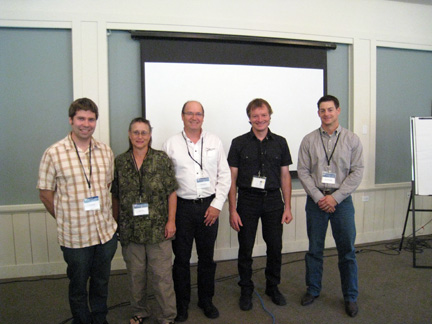
Monday morning session (l to r) Scott Pavey, Joan Trial, Richard Vallee, Marc Minglebier and Graham Goulette (moderator).

Monday morning session (l to r) Julie Deschene, Joan Trial, Lyne Morissette, Scott Craig and Graham Goulette (moderator).

Monday afternoon session (l to r) Kathryn Collet (moderator), Melanie Dionne, Phillipe Brodeur, Luke Poirier, Danielle Quinn.

